A
Auto Express
Guest
Part of the magic of cars in the supermini class is that they can be fun to drive, more so than some much more expensive cars, without being pricey to run. The new Ford Fiesta is no exception to that rule, and its range of small-capacity petrol, hybrid and diesel engines are very frugal.
It’s not just about fuel economy, as purchase price and even the cost of fuel plays a big part in how cheap a car is to run.
The petrol 1.0-litre EcoBoost with 94bhp provides a good overall package. It emits 116g/km of CO2 and returns up to 55.4mpg, which is competitive in its class - most 1.0-litre turbocharged petrols, such as the ones in the Skoda Fabia, SEAT Ibiza and Suzuki Swift will produce very similar figures.
However, the 1.0-litre mild-hybrid models also provide a convincing case for potential customers. The 123bhp version, in popular Titanium trim, is only £720 more expensive than the regular 94bhp petrol-powered car, and is able to return 56.5mpg on the combined cycle, while emitting just 114g/km of CO2. The extra power of the 153bhp hybrid variant costs just an extra £320 on top of that, but delivers almost the same economy as the 94bhp petrol model at 55.4mpg, with a small increase in CO2 emissions to 116g/km.
The standard 123bhp version of the EcoBoost engine with a seven-speed auto transmission, returns 49.6mpg, and emits 129g/km of CO2, whereas the 1.1-litre 74bhp unit mated to a five-speed gearbox returns 53.3mpg and 121g/km.
For some buyers the old diesel model may make sense, as it returned the highest mpg figures of the range. The 84bhp 1.5-litre TDCi was the ultimate choice for economy, thanks to figures of 65.7mpg and 112g/km of CO2.
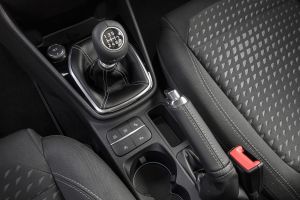
Ford Fiesta - interior detail
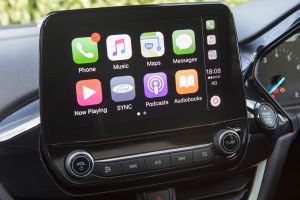
Spend another £300 for and you get a ten speaker Bang & Olufsen stereo.
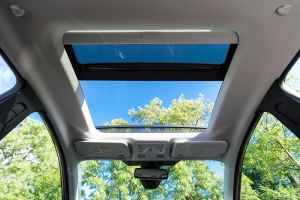
Ford Fiesta - panoramic roof

Ford Fiesta - front red
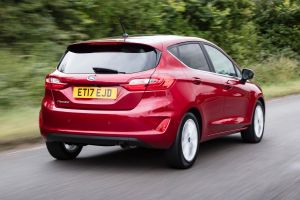
Ford Fiesta - rear red
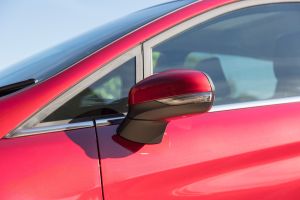
Ford Fiesta - wing mirror red
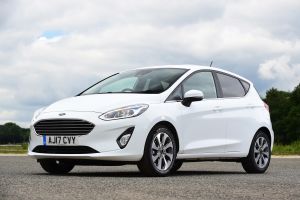
Ford Fiesta - front static

Ford Fiesta - profile
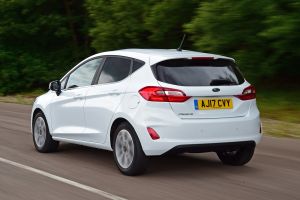
Ford Fiesta - rear
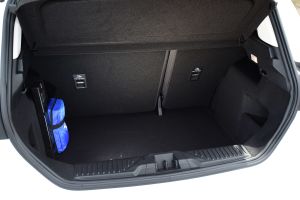
Ford Fiesta - boot

Ford Fiesta - rear detail
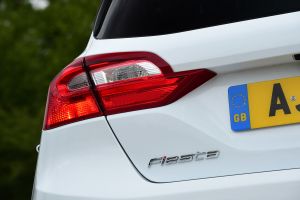
Our Choice: Ford Fiesta Zetec 1.0 EcoBoost (100PS).
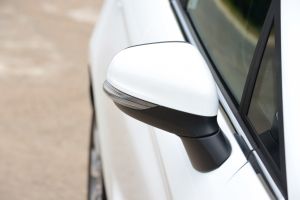
Ford Fiesta - wing mirror
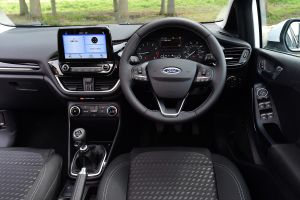
The interior is a big change with upmarket materials and a more modern layout.
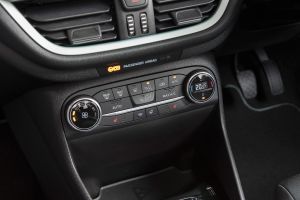
The cabin has ergonomically placed controls, while soft-touch materials replace hard plastic panels.
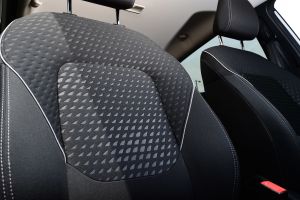
Ford Fiesta - front seat detail

Ford has improved the Fiesta to keep it on top of the UK’s car sales charts.
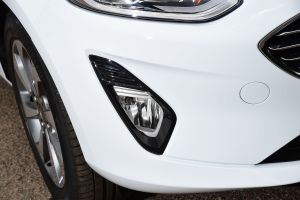
Ford Fiesta - fog light
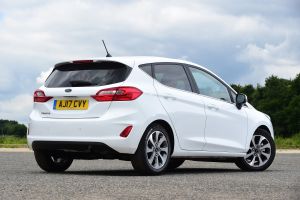
The changes made to rear end styling give it a different stance on the road.
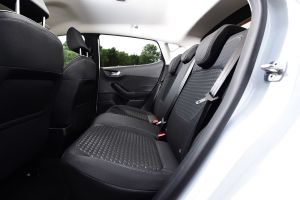
It feels a little bit more spacious inside with decent space in the back seats. While the boot is slightly larger too, with a wider opening than before.
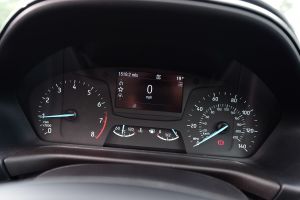
Ford Fiesta - dials
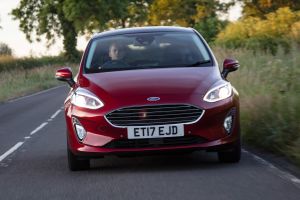
The design change is evolutionary as the car used the same platform as before.
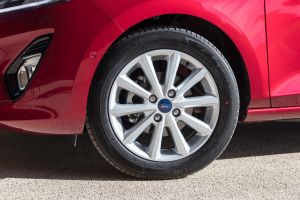
Ford Fiesta - wheel
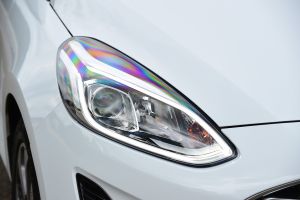
Ford Fiesta - front light
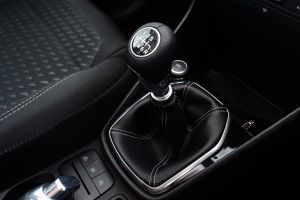
Ford Fiesta - transmission
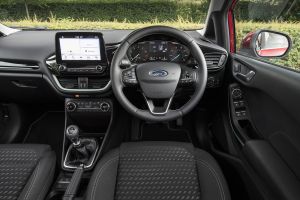
You get to choose from a basic 6.5-inch system and an 8-inch running Ford’s SYNC3 software.
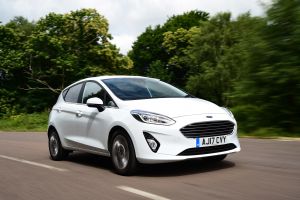
Ford Fiesta - front action
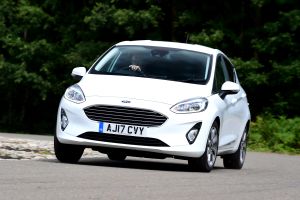
Ford Fiesta - front cornering
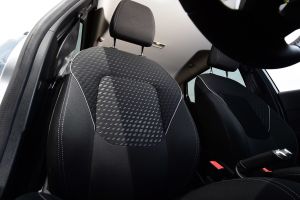
Ford Fiesta - front seat
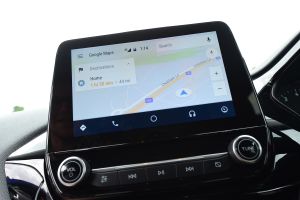
Ford Fiesta - sat-nav
Entry-level Fiesta Trend cars with the 74bhp 1.1-litre petrol are the cheapest to insure, sitting in insurance group 4E. The 94bhp EcoBoost model in Titanium trim, sits in group 10E - that should make it very affordable for most drivers to insure. However, the 197bhp ST-2 and ST-3 models incur higher premiums as they're both in group 28E.
Experts tell us that after three years and an average of 36,000 miles, a Ford Fiesta will hold on to around 39% of its value, which is pretty good for what’s likely to continue being the top-selling car in the UK. The ST-2 and ST-3 models fare slightly better than average, retaining 45% over the same period.
Continue reading...
It’s not just about fuel economy, as purchase price and even the cost of fuel plays a big part in how cheap a car is to run.
The petrol 1.0-litre EcoBoost with 94bhp provides a good overall package. It emits 116g/km of CO2 and returns up to 55.4mpg, which is competitive in its class - most 1.0-litre turbocharged petrols, such as the ones in the Skoda Fabia, SEAT Ibiza and Suzuki Swift will produce very similar figures.
- SEE MORE Most economical cars on sale now
However, the 1.0-litre mild-hybrid models also provide a convincing case for potential customers. The 123bhp version, in popular Titanium trim, is only £720 more expensive than the regular 94bhp petrol-powered car, and is able to return 56.5mpg on the combined cycle, while emitting just 114g/km of CO2. The extra power of the 153bhp hybrid variant costs just an extra £320 on top of that, but delivers almost the same economy as the 94bhp petrol model at 55.4mpg, with a small increase in CO2 emissions to 116g/km.
The standard 123bhp version of the EcoBoost engine with a seven-speed auto transmission, returns 49.6mpg, and emits 129g/km of CO2, whereas the 1.1-litre 74bhp unit mated to a five-speed gearbox returns 53.3mpg and 121g/km.
For some buyers the old diesel model may make sense, as it returned the highest mpg figures of the range. The 84bhp 1.5-litre TDCi was the ultimate choice for economy, thanks to figures of 65.7mpg and 112g/km of CO2.

Ford Fiesta - interior detail

Spend another £300 for and you get a ten speaker Bang & Olufsen stereo.

Ford Fiesta - panoramic roof

Ford Fiesta - front red

Ford Fiesta - rear red

Ford Fiesta - wing mirror red

Ford Fiesta - front static

Ford Fiesta - profile

Ford Fiesta - rear

Ford Fiesta - boot

Ford Fiesta - rear detail

Our Choice: Ford Fiesta Zetec 1.0 EcoBoost (100PS).

Ford Fiesta - wing mirror

The interior is a big change with upmarket materials and a more modern layout.

The cabin has ergonomically placed controls, while soft-touch materials replace hard plastic panels.

Ford Fiesta - front seat detail

Ford has improved the Fiesta to keep it on top of the UK’s car sales charts.

Ford Fiesta - fog light

The changes made to rear end styling give it a different stance on the road.

It feels a little bit more spacious inside with decent space in the back seats. While the boot is slightly larger too, with a wider opening than before.

Ford Fiesta - dials

The design change is evolutionary as the car used the same platform as before.

Ford Fiesta - wheel

Ford Fiesta - front light

Ford Fiesta - transmission

You get to choose from a basic 6.5-inch system and an 8-inch running Ford’s SYNC3 software.

Ford Fiesta - front action

Ford Fiesta - front cornering

Ford Fiesta - front seat

Ford Fiesta - sat-nav
Insurance groups
Entry-level Fiesta Trend cars with the 74bhp 1.1-litre petrol are the cheapest to insure, sitting in insurance group 4E. The 94bhp EcoBoost model in Titanium trim, sits in group 10E - that should make it very affordable for most drivers to insure. However, the 197bhp ST-2 and ST-3 models incur higher premiums as they're both in group 28E.
Depreciation
Experts tell us that after three years and an average of 36,000 miles, a Ford Fiesta will hold on to around 39% of its value, which is pretty good for what’s likely to continue being the top-selling car in the UK. The ST-2 and ST-3 models fare slightly better than average, retaining 45% over the same period.
Continue reading...
